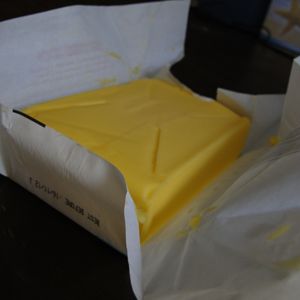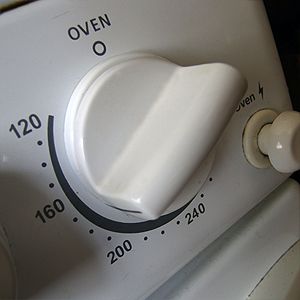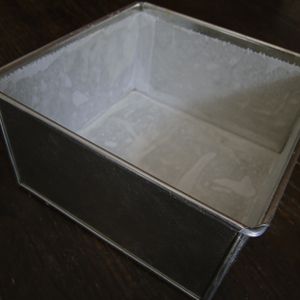Back To Basics :: Kitchen Tips and Tricks #1
One of my favourite things about food blogs on the internet is getting exposure to all new dishes and ideas: it's lovely seeing everyone elses creations. But as united as the interwebs makes us, we're still divided by a common language. Ingredients have different names, measurements can mean different things, terminology can sound foreign. So I'm writing a series of posts to help troubleshoot some of the most common questions and problems I've found or been asked about around the internet.
The secret to being a good baker is to be an organised baker. It's no secret that I am not an organised baker. In fact, baking in my kitchen leaves it looking as if a tornado invaded it. "Baking powder? WHERE'S MY BAKING POWDER? FIND ALL THE BAKING POWDER!"
Having all your ingredients ready to go, and even measured out will make your kitchen endeavors all the more successful. But even if you're a tornado in the kitchen like me, there are three things you absolutely must do before unleashing your mighty fury on the dish at hand.

1. Take your butter out of the fridge
Unless your recipe specifically asks for chilled butter (usually required for the rubbing method) or asks you to melt it, take it out of the fridge before you do anything else. The length of time you need to do this for will depend on the temperature in your room: you need your butter to be soft, but you don't want it so soft that it starts to melt for reasons explained below. If your butter has not reached room temperature prior to mixing, it may not be evenly incorporated into the batter and that will result in an uneven texture in the final product.
What to do if you forget to bring your butter room temperature?
Chop your butter into tiny squares: by the time you have done the next three steps, got all your equipment ready and measured out all your ingredients, your butter will probably have come to room temperature already (pending on your room temperature. of course).
Definitely do not soften it in the microwave. I see a lot of people wondering why their cookies spread too far, or why their cake didn't rise properly, only to find out that they nuked their butter.
Baking is science for hungry people.
Flour mixes have a set sequence of chemical reactions required to make your baked goods turn out the way they should. For example, when using the creaming method, beating the sugar into the butter incorporates air into the mixture and allows the sugar granules to cut tiny holes into the butter. When dry heat is added to the mixture in your oven, all the fats and sugars melt, then the raising agent gives off carbon dioxide which stretches the protein inside the flour called 'gluten'. The starch grains will then burst, absorbing the melted fat, sugar and other liquids.
If your butter was melted before mixing, the water in the butter separates and melts the sugar as you are combining the ingredients, disrupting this sequence. Similarly, the melted fat will coat your flour, preventing it from making enough gluten. This will completely change the texture of your mixture.
It seems like such a simple thing, but it can make a big difference to the final product!

2. Preheat your oven.
Having your oven at the right temperature before you put the batter into it is important when setting off the aforementioned chemical reactions. This is why it is also important to not leave the door open too long when adding or checking on things, and why it is important to control the impulse to check on your bakerages progress.
If the temperature in your oven is too low, the final product may turn out dry, could result in a close and heavy texture, can cause it to rise unevenly or sink in the centre. Too high and you may have a coarse and open texture, cracked surface, over-bake the exterior or end up with a peak in the centre.
Some ovens will tell you when it has reached the correct temperature. Mine doesn't, so I turn it on before I start mixing the ingredients. By the time you're done it should be fine.

3. Line, grease or prepare your tins
I've heard people say that they always line or grease the cake tin last because it is their least favourite part of baking. While it may feel like a chore, while you are messing around with this last minute, your batter could be spoiling.
Recipes containing cream of tartar or bicarb soda need to be baked immediately. This includes recipes calling for self-raising flour (flour into which the leavening agent is already incorporated). The moment they come into contact with the liquid, they begin reacting. If left to stand they will deteriorate and will not react properly with the fats and lipids in your batter. It's best to make a habit of having the cake tin ready to go and getting it into your oven the moment you have finished mixing your batter.
The secret to being a good baker is to be an organised baker. It's no secret that I am not an organised baker. In fact, baking in my kitchen leaves it looking as if a tornado invaded it. "Baking powder? WHERE'S MY BAKING POWDER? FIND ALL THE BAKING POWDER!"
Having all your ingredients ready to go, and even measured out will make your kitchen endeavors all the more successful. But even if you're a tornado in the kitchen like me, there are three things you absolutely must do before unleashing your mighty fury on the dish at hand.

1. Take your butter out of the fridge
Unless your recipe specifically asks for chilled butter (usually required for the rubbing method) or asks you to melt it, take it out of the fridge before you do anything else. The length of time you need to do this for will depend on the temperature in your room: you need your butter to be soft, but you don't want it so soft that it starts to melt for reasons explained below. If your butter has not reached room temperature prior to mixing, it may not be evenly incorporated into the batter and that will result in an uneven texture in the final product.
What to do if you forget to bring your butter room temperature?
Chop your butter into tiny squares: by the time you have done the next three steps, got all your equipment ready and measured out all your ingredients, your butter will probably have come to room temperature already (pending on your room temperature. of course).
Definitely do not soften it in the microwave. I see a lot of people wondering why their cookies spread too far, or why their cake didn't rise properly, only to find out that they nuked their butter.
Baking is science for hungry people.
Flour mixes have a set sequence of chemical reactions required to make your baked goods turn out the way they should. For example, when using the creaming method, beating the sugar into the butter incorporates air into the mixture and allows the sugar granules to cut tiny holes into the butter. When dry heat is added to the mixture in your oven, all the fats and sugars melt, then the raising agent gives off carbon dioxide which stretches the protein inside the flour called 'gluten'. The starch grains will then burst, absorbing the melted fat, sugar and other liquids.
If your butter was melted before mixing, the water in the butter separates and melts the sugar as you are combining the ingredients, disrupting this sequence. Similarly, the melted fat will coat your flour, preventing it from making enough gluten. This will completely change the texture of your mixture.
It seems like such a simple thing, but it can make a big difference to the final product!

2. Preheat your oven.
Having your oven at the right temperature before you put the batter into it is important when setting off the aforementioned chemical reactions. This is why it is also important to not leave the door open too long when adding or checking on things, and why it is important to control the impulse to check on your bakerages progress.
If the temperature in your oven is too low, the final product may turn out dry, could result in a close and heavy texture, can cause it to rise unevenly or sink in the centre. Too high and you may have a coarse and open texture, cracked surface, over-bake the exterior or end up with a peak in the centre.
Some ovens will tell you when it has reached the correct temperature. Mine doesn't, so I turn it on before I start mixing the ingredients. By the time you're done it should be fine.

3. Line, grease or prepare your tins
I've heard people say that they always line or grease the cake tin last because it is their least favourite part of baking. While it may feel like a chore, while you are messing around with this last minute, your batter could be spoiling.
Recipes containing cream of tartar or bicarb soda need to be baked immediately. This includes recipes calling for self-raising flour (flour into which the leavening agent is already incorporated). The moment they come into contact with the liquid, they begin reacting. If left to stand they will deteriorate and will not react properly with the fats and lipids in your batter. It's best to make a habit of having the cake tin ready to go and getting it into your oven the moment you have finished mixing your batter.